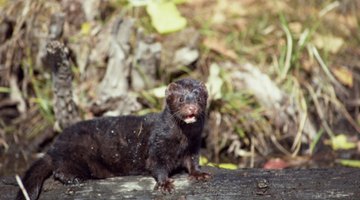How to Get Rid of Minks
Minks are generally bred so that their fur can be used for coats. They are considered valuable because of their fur, but minks can be nuisances in the wild.

In nature, they live in environments near bodies of water and marshes and often eat animals that people hunt, such as ducks or game birds, according to Pest Control U.K. If they get on farms, they sometimes eat farm animals such as chickens. Different methods work for getting rid of minks, including trapping or killing them.
Things You Will Need
- Gauge wire
- Poultry netting
- Traps
- Shovel
- Bait
- Hunting rifle
- Cage
Tip
Try to sell a mink you trapped, but the animal will be killed for its fur if you go this route. Talk to mink sellers about trapping or killing minks on your property, if you don’t wish to be the one to take care of a mink problem.
Warning
Minks become very aggressive toward animals or people trying to harm them or their offspring or those who get into their territories.
-
Build a fence around your property to keep minks from getting to your chickens or other animals. Use a fence with galvanized sheeting and gauge wire to keep minks out, according to Broad Leys Publishing. Build a fence that is at least five feet tall. To further keep minks out of your property, put rags containing gasoline on or near your fence, being careful not to bring lighters, matches or combustible materials near your fence, according to the publishing company. Place poultry netting around chicken coups to further protect your property from minks.
-
Place body-grip, double-door or leg-hold traps on or near your property to try to capture minks if you are unsuccessful in keeping them off your property with fencing, according to United Wildlife Control. Place traps near mink dens, which are usually narrow holes or spaces. Minks often live in other animals’ holes, such as burrows by muskrats or beavers, or in fallen logs. The animals tend to find new homes frequently, which makes them hard to capture. Place traps in riverbank areas or in runs minks use to move from one place to another. After you catch them, either move the minks to another location, take them to an animal control agency or shoot them, depending on laws and your preferences.
-
Dig a hole for a trap and put food, such as fish or frogs, into the trap to capture minks if regular trapping methods don't work. Place the hole in a riverbank and fill it with a minimal amount of water to have a better chance to catching minks, according to the agency. After you catch one or more minks, use a cage to move them.
-
Shoot minks when you see them on your property, if you are legally allowed to do so and don't wish to try to trap them. Look for mink dens and signs of minks, such as killed prey, to find the animals. Check your state’s laws on hunting minks before killing them because some states have designated hunting seasons for minks. Most states allow home owners to shoot minks on their property, according to United Wildlife Control.
-
Wait for natural predators of minks, such as red foxes or coyotes, to get a mink that have been causing problems on your property or hunting grounds if you don't wish to spend time trapping them. Don’t wait too long for natural predators to get minks, as they breed in the spring and usually have about five to six kittens, according to Pest Control U.K.
-
Hire a professional or call an animal control agency to help you to get rid of minks, especially if you have no experience dealing with pests. It will cost you money to get a professional, but you won’t have to deal with traps or a hunting rifle, both of which can be dangerous if not handled correctly.
The Drip Cap
- Minks are generally bred so that their fur can be used for coats.
- They are considered valuable because of their fur, but minks can be nuisances in the wild.
- Build a fence around your property to keep minks from getting to your chickens or other animals.
- Use a fence with galvanized sheeting and gauge wire to keep minks out, according to Broad Leys Publishing.
- Build a fence that is at least five feet tall.
- Wait for natural predators of minks, such as red foxes or coyotes, to get a mink that have been causing problems on your property or hunting grounds if you don't wish to spend time trapping them.
References
Resources
Writer Bio
Laura Latzko is a freelance writer based in Phoenix, Ariz. She has reported for the "Columbia Missourian," "Columbia Daily Tribune," "Downtown Express" and "Washington Times." She holds a Master of Arts in journalism from the University of Missouri.
Photo Credits
- Jupiterimages/Photos.com/Getty Images
- Jupiterimages/Photos.com/Getty Images
More Articles



